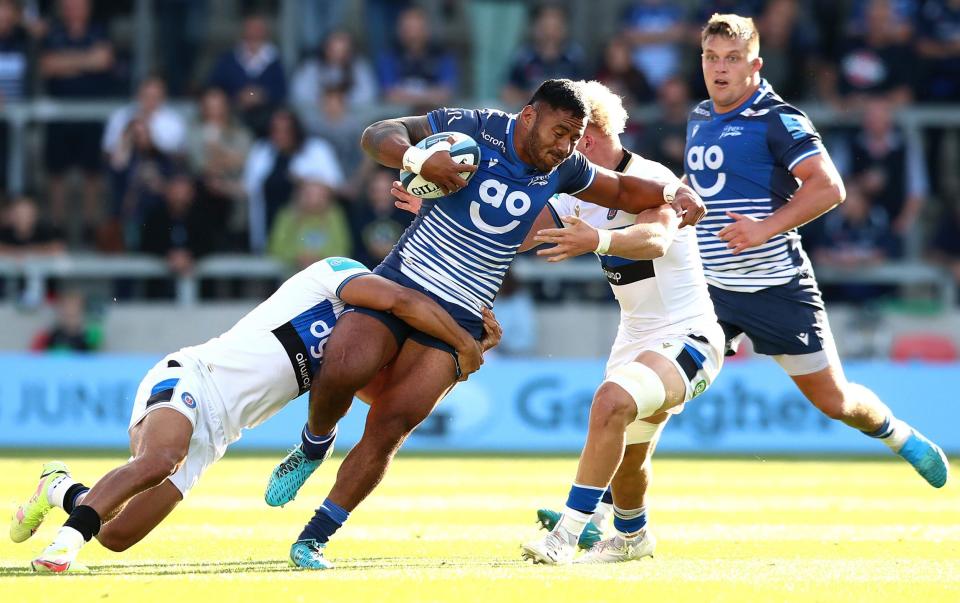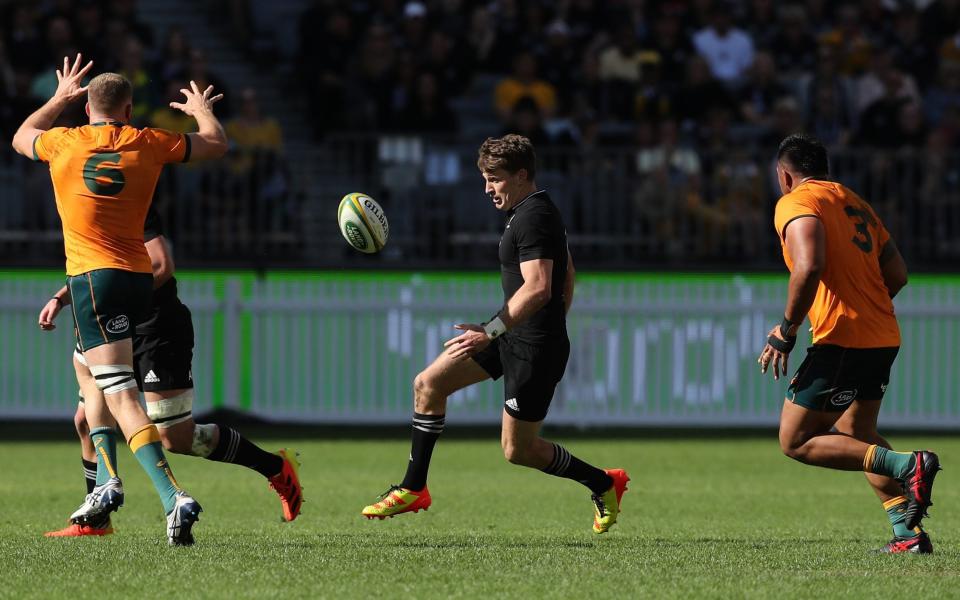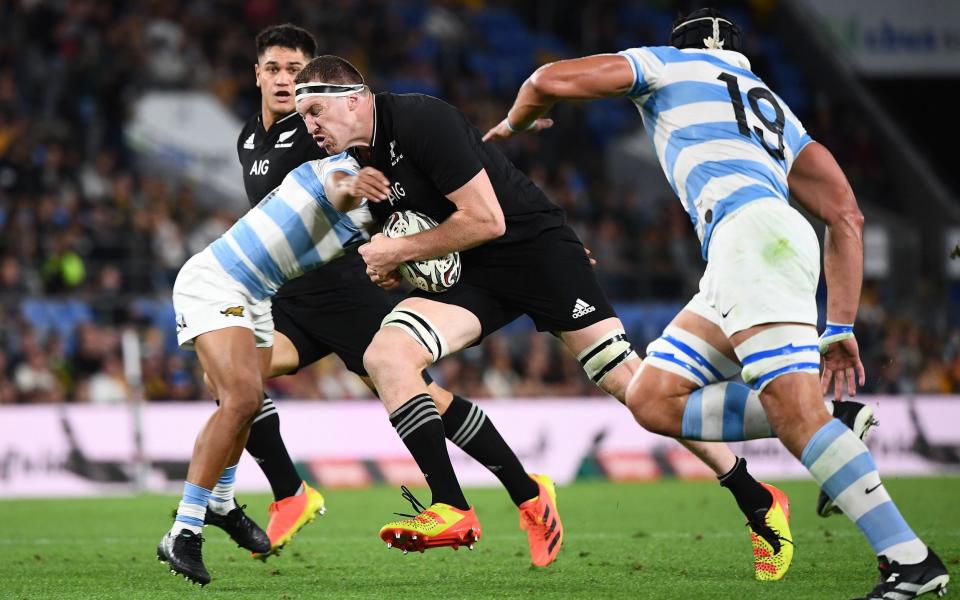The Bruise Brothers: Manu Tuilagi sheds kilos after home truths but loses none of his devastating power

Manu Tuilagi seems a good-humoured, affable chap. All the same, you would have to be pretty bold to suggest that he lose a few pounds.
It was fellow Sale Sharks centre Rohan Janse van Rensburg who plucked up the courage. While shooting pool a few days after last season’s play-off semi-final defeat by Exeter Chiefs, the South African went quiet for a moment.
“We were having a bit of coffee and he said, ‘Can I ask you a question?’” remembers a grinning Tuilagi.
“I said he could, he said, ‘Nah, nah, don’t worry, don’t worry’. I said, ‘Why are you saying that? What was the question?!’”
A simple one that led to a bit of soul-searching, as it turned out. Janse van Rensburg, a similarly devastating ball-carrier - he and Tuilagi are nicknamed ‘Beast’ and ‘Chief’ respectively - had been wondering whether his colleague felt fit enough during the 40-30 loss at Sandy Park.
“It was a tough question to answer, but nothing hurts like the truth,” Tuilagi concedes. “I was one or two kilos too heavy. Running around for 80 minutes, those two kilos can weigh you down quite a bit.
“We thought [let’s] lose a bit of weight, and that will allow us to be a bit more mobile, a bit more agile, and use less energy. Have a bit more precision in the way you can play the game.”
They each set out to shed “four or five kilos”, which may not sound like a great deal when you consider that Tuilagi is listed at 110kg or 111kg on most databases. The goal has nearly been reached, though, thanks to a more disciplined diet and fewer snacks later in the day.
Tuilagi looks discernibly leaner and has started the season strongly. He lasted the entire 80 minutes of Sale’s 20-19 victory over Bath on Saturday and recorded 17 attacking touches, a figure he has only surpassed four times in 85 Premiership appearances since Opta started measuring that metric in 2011-12.
Now, he can admit that frustration used to creep in on the field because of his fitness levels. A constructive pre-season has sharpened Tuilagi’s resolve.
“Yeah, probably [I would feel frustrated],” he adds. “Especially when the game got tougher. On the weekend I felt a lot better - mentally especially.
“The way we have been training, it is just another day at the office when the games get tough on the weekends - just another fast and furious day, just another Thursday.”
Alex Sanderson, the Sale director of rugby, praises Janse van Rensburg’s prompting of Tuilagi as an act that reinforces the culture of internal accountability he is trying to foster.
Sanderson also points out that World Rugby is aiming for greater ball-in-play time with the 50:22 kicking law and quicker breakdowns. As such, players may have to become accustomed to travelling longer distances during matches.
“As well as the extra space, all these things lend themselves to high accelerations in the forwards and repeat top speeds with the backs,” explains Sanderson, whose charges face London Irish on Sunday.
“If the game continues to go down this route, as the trend has been for the last 12 years, you are going to find the bulkier fellas having to shed a bit of weight so they can repeat high-intensity efforts.”
Eddie Jones is on board with a trimmer Tuilagi as well. Last month marked a decade since Tuilagi’s England debut, which came against Wales on the eve of the 2011 Rugby World Cup.
Jones named the 30 year-old in his 45-man squad for a training camp next week, hinting that Tuilagi remains part of England’s plans ahead of 2023.
The man himself is confident that he will retain his power, stressing that “mentality” is the most important weapon in the physical battle anyway: “You can be the smallest guy and still run through brick walls.”
“I have lost a bit of weight but I am not 90kg!” Tuilagi adds. “I am still over 100kg. [Jones] loves it. We had a chat and he just said, ‘Keep fit and play well’.”
History tells us that Tuilagi tends to meet that second objective as long as he avoids problems with the first one. Hopefully, a slightly more slender frame can help.
Time to downsize? Why others are following All Blacks' tactic of no longer making smaller players bigger

“Frightening” is the word that Nic Gill volunteers to describe the size of rugby union’s modern-day athletes.
Part of the All Blacks’ strength and conditioning department for 14 years, Gill reckons the mass of New Zealand forwards has increased by an average of one kilogram per year since he has been with the team.
It is with a laugh that he discloses that Brodie Retallick, the exceptional lock, has relocated the weight he lost over a lucrative stint in free-flowing Japanese club rugby. All that said, Gill outlines an interesting culture shift.
“When I first started, it was all about trying to get bigger,” he explains at the announcement of WattBike’s new official partnership with New Zealand Rugby.
“Now we don’t have that focus at all. In essence, we are trying to get some of our athletes smaller because they are getting so big that they can’t do their job on the park.

“There is a difference in size of 56 kilos between our smallest and biggest person… that’s almost another whole body, so we have a huge difference in size. When I first started, we tried to make those smaller people bigger. In New Zealand, we don’t do that anymore because we don’t need to. They can do their job at the size they are.
“We definitely aren’t chasing gains in weight with the All Blacks. We’re chasing them being able to do their job for 80 minutes.”
It has been tempting to sell this weekend’s 100th Test between New Zealand and South Africa in Townsville as a fascinating battle for the soul of the 15-a-side game between two distinct playing styles.
In the green and gold corner, the world champion Springboks: kings of kick-pressure, set-piece muscle and ferocious defence. Their challengers, the All Blacks: ever-alert to attacking opportunities and intuitive ways of finding space with passes, offloads and chips from impish playmakers such as Beauden Barrett, Richie Mo’unga and Damian McKenzie.

Of course, that is a primitive contrast. At their best, both of these teams tick column B as well as column A. New Zealand’s scrummaging is no pushover. South Africa full-back Willie le Roux is one of the most skilful attackers around.
Billing the Springboks as Goliath for this contest would be to ignore the influence of diminutive superstars such as scrum-half Faf de Klerk and electric wing Cheslin Kolbe – even if the latter is currently injured. According to World Rugby figures, the All Blacks were second only to Tonga at the 2019 World Cup when it came to the average body mass of their squad (107kg).
But there is clearly a desire among administrators to increase ball-in-play time. Referees have been asked to facilitate quick, clean rucks and the 50:22 kicking law has been introduced in a bid to create more space on the pitch by encouraging defensive wings to hang back.
In 2018, the average cycle of play lasted 36 seconds, up from 13 seconds in 1987. Around 19 per cent of cycles surpassed one minute. Should the 50:22 cause teams to hug touchlines, those numbers will surely increase.
New Zealand do seem well suited to this. Both they and South Africa have played eight Tests each in 2021 so far. Curiously, ball-in-play time statistics are fairly even. Matches featuring South Africa have averaged 29 minutes and nine seconds according to Opta. Matches featuring New Zealand have averaged 29 minutes and 36 seconds.
Digging a little deeper, though, there has around 10 more minutes of ‘dead time’, on average, in South Africa’s outings. We can work out that the ratio of work to rest is 0.467 when New Zealand have played and 0.399 in South Africa’s matches. Tries tend to dent ball-in-play time, too. New Zealand’s matches have featured a total of 77 tries, with South Africa’s matches yielding exactly 50 fewer.
All of this would seem to support the notion that the Springboks thrived when the contests against the British and Irish Lions became into stop-start slug-fests. Not including the half-time break, the second Test of that series lasted one hour, 55 minutes and 37 seconds. It is a safe bet that New Zealand will endeavour to keep the ball on the field this weekend.
On announcing an England training squad that contained Sam Simmonds and Alex Dombrandt at the expense of Billy Vunipola, Eddie Jones decreed that rugby union “is evolving nicely” after “coming through some difficult times”.
“The refereeing is starting to get a little bit more consistent around the breakdown,” said the Australian. “That is allowing teams to play with a bit more freedom and space because the ball is quicker.”
During pre-season, Jones gave a presentation on game trends to senior figures from all 13 Premiership clubs. Sale director of rugby Alex Sanderson was among them, and heard about how the speed of breakdowns is generally increasing. He has seen two of his hard-carrying centres, Manu Tuilagi and Rohan Janse van Rensburg, slim down in a bid to contribute more.
“It’s the way the game is going with more metres in play and faster ruck-speed,” he said. “As well as the extra space, all these things [refereeing and kicking laws] lend themselves to high accelerations in the forwards and repeated top speeds with the backs. At international level, which is Manu’s level, a player is running 116 metres per minute.
“If the game continues to go down this route, as the trend has been for the last 12 years, you are going to find the bulkier fellas having to shed a bit of weight so they can do repeat high intensity efforts.”
Gill keeps his cards close to his chest when asked about what physiological developments could come out of the 50:22 law. He points out that “everyone has huge athletes trying to dominate the collision space and the opposition has to match it”. There are “no huge shifts” around the corner in that regard, Gill says.
In time, though, he believes a plateau could be coming because “as a spectator sport, there is probably a desire to remove some of the stoppages in the game and, if that happens, players will have to be fitter to play longer”. A recent research paper from South African sports scientist Ross Tucker, with insights from Stuart Lancaster and other elite coaches, hinted as much.
So we had a rugby research paper published. A pretty cool paper IMO, describing the evolution of international player mass from 1991 to 2019 in men, and 2010 to 2014 in women. Best of all, some insights come from top coaches - Lancaster, Davies & Street https://t.co/AnhDEobg8T
— Ross Tucker (@Scienceofsport) January 5, 2021
This week, as if to accentuate the demands on tight-five forwards, Gill put 126kg prop Angus Ta’avao through a brutal-sounding WattBike work-out. Ta’avao needed to complete 10 back-to-back 1km time trials, with a three-minute break in between them. His first interval was allowed to be one minute and 45 seconds, but each subsequent one had to get quicker. Ta’avao “nailed it”, Gill reveals. “He finished his last rep at 1:04.”
New Zealand’s meeting with South Africa is all the more fascinating because it could provide a glimpse into the future as two philosophies collide.
“Whatever the team’s game plan, you’ve got to be able to do your job,” Gill says. “And if you can’t be in the right place quickly enough because you are too big, then you have to get smaller or fitter…. or both.”

 Yahoo Sport
Yahoo Sport 





































